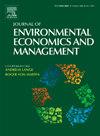More than particulates matter: Multiple pollutants and productivity in Indian call centers
IF 5.9
3区 经济学
Q1 BUSINESS
Journal of Environmental Economics and Management
Pub Date : 2025-08-13
DOI:10.1016/j.jeem.2025.103181
引用次数: 0
Abstract
We measure the impact of three components of air pollution on daily labor productivity in call centers in five Indian cities. We find that a one standard deviation increase in fine particulate matter (PM2.5), a pollutant that has been the primary focus of the literature on the harms of air pollution, has a large negative effect of on an index of intensive margin productivity. Notably, we find a comparable negative effect for a one standard deviation increase in carbon monoxide (CO) of as well as a negative effect of from ozone (O3). For one of our main productivity variables, the number of calls per shift, one standard deviation increases in PM2.5, CO and O3 lead to declines relative to the mean of 11.8 %, 10.6 % and 6.0 %, respectively. In summing air pollution harms across our sample, CO is responsible for more than half of the total productivity lost, which is more than double the losses attributable to PM2.5. We then illustrate the potential productivity impacts of an existing national policy in India that targets PM2.5 compared to a counterfactual policy that also targets CO and O3.
不仅仅是颗粒物:印度呼叫中心的多重污染物和生产力
我们测量了空气污染的三个组成部分对五个印度城市呼叫中心的日常劳动生产率的影响。我们发现,细颗粒物(PM2.5)的一个标准差增加,对集约边际生产率指数有0.15σ的巨大负影响,PM2.5是一种一直是空气污染危害文献的主要焦点的污染物。值得注意的是,我们发现一氧化碳(CO)每增加一个标准差就会产生0.14σ的负面影响,臭氧(O3)也会产生0.09σ的负面影响。对于我们的主要生产力变量之一,每班的呼叫次数,PM2.5, CO和O3的一个标准差增加导致相对于平均值分别下降11.8 %,10.6 %和6.0 %。在对我们样本中的空气污染危害进行汇总后发现,二氧化碳造成的生产力损失占总生产力损失的一半以上,是PM2.5造成的损失的两倍多。然后,我们说明了印度现有的以PM2.5为目标的国家政策与以CO和O3为目标的反事实政策的潜在生产力影响。
本文章由计算机程序翻译,如有差异,请以英文原文为准。
求助全文
约1分钟内获得全文
求助全文
来源期刊
CiteScore
8.00
自引率
4.30%
发文量
91
期刊介绍:
The Journal of Environmental Economics and Management publishes theoretical and empirical papers devoted to specific natural resources and environmental issues. For consideration, papers should (1) contain a substantial element embodying the linkage between economic systems and environmental and natural resources systems or (2) be of substantial importance in understanding the management and/or social control of the economy in its relations with the natural environment. Although the general orientation of the journal is toward economics, interdisciplinary papers by researchers in other fields of interest to resource and environmental economists will be welcomed.

 求助内容:
求助内容: 应助结果提醒方式:
应助结果提醒方式:


